What Is The Most Dangerous Ocean Animal
If you had to judge, would you say more dangerous animals live on country or in the ocean?
Personally, I take no clue. But considering that more than 80 per centum of our oceans are still unexplored, at that place's likely some deadly, Lovecraftian-style creepy crawlies lurking in the depths. All the same, for fearfulness of fearfulness-mongering (the irony!), permit'south be clear: the oceans remain relatively safe for humans. I mean, when was the last time you got into a tussle with a Beaked Sea Serpent?
And then, this is a listing for the surfing sadist. It'south for the surfers who wonder, however unlikely, about what can kill them while they're sitting out in the lineup. This is not for the "out of sight, out of mind" crowd. Consider yourself warned.
Box Jellyfish
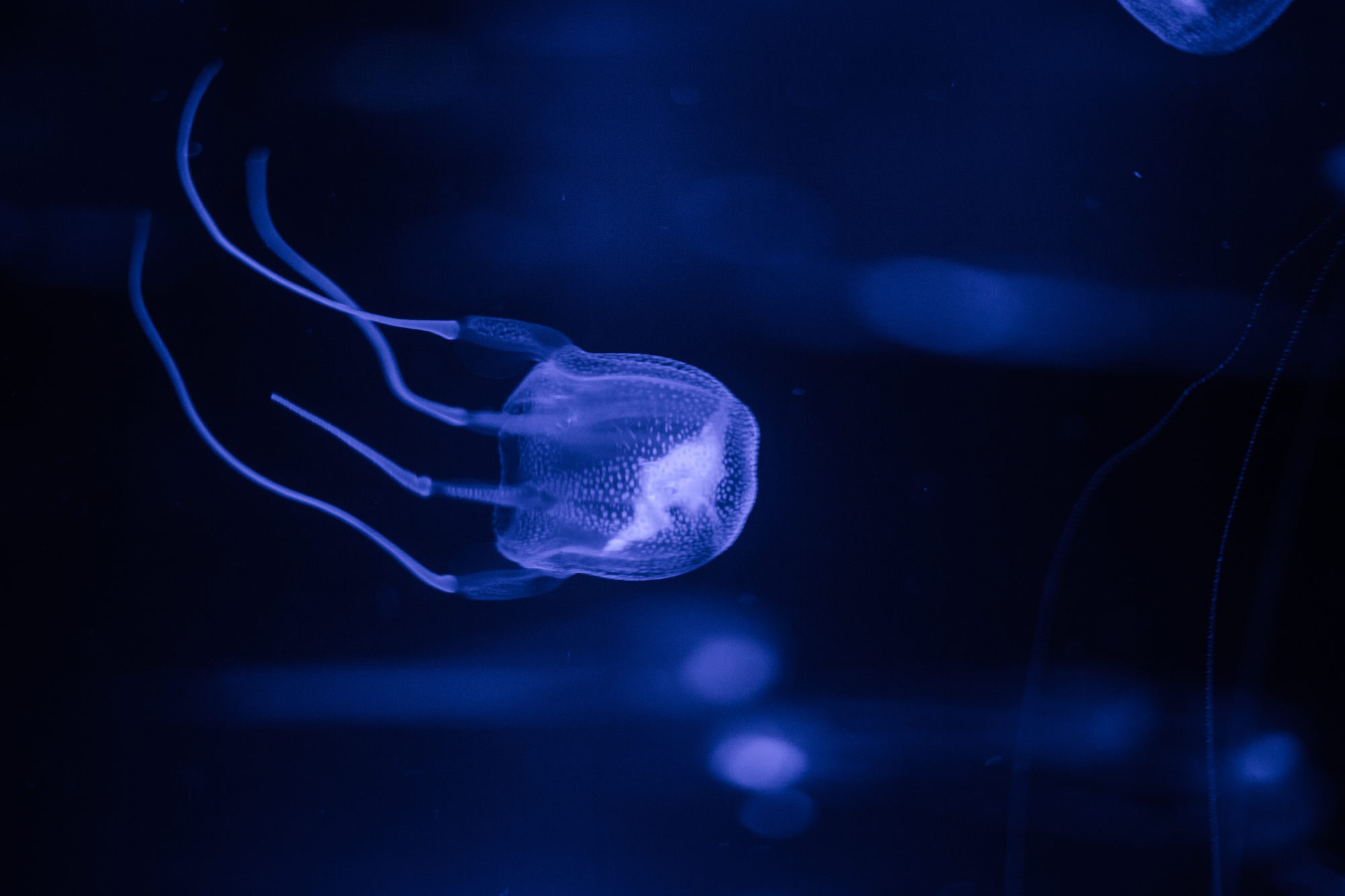
A Box Jellyfish, seen from the safety of tempered aquarium glass. Photo: Dewald Kirsten/Shutterstock
Without a marine biology degree, you may think of the box jellyfish as a single, disturbingly lethal breed of jelly wreaking havoc primarily upon Australia. That's what the headlines make it out to be. Just actually, there are over 50 species of box jellyfish with varying degrees of deadliness. The worst of the family being Chironex fleckeri, or the body of water wasp, which delivers a sting that can result in cardiac arrest.
What to do if you lot encounter one: Since many box jellyfish species are exceptionally tiny (and translucent), y'all'll probable experience it earlier you meet it. If stung, call emergency services immediately. Treatment methods include dousing with vinegar, anti-venom, and resuscitation if necessary.
Where to find 'em: During the summer months (Nov to March), unlike species of box jellyfish are arable in northern Commonwealth of australia. In fact, protective nets have been installed at many beaches in northern Queensland to preclude encounters betwixt the jellies and surfers/swimmers.
Stonefish
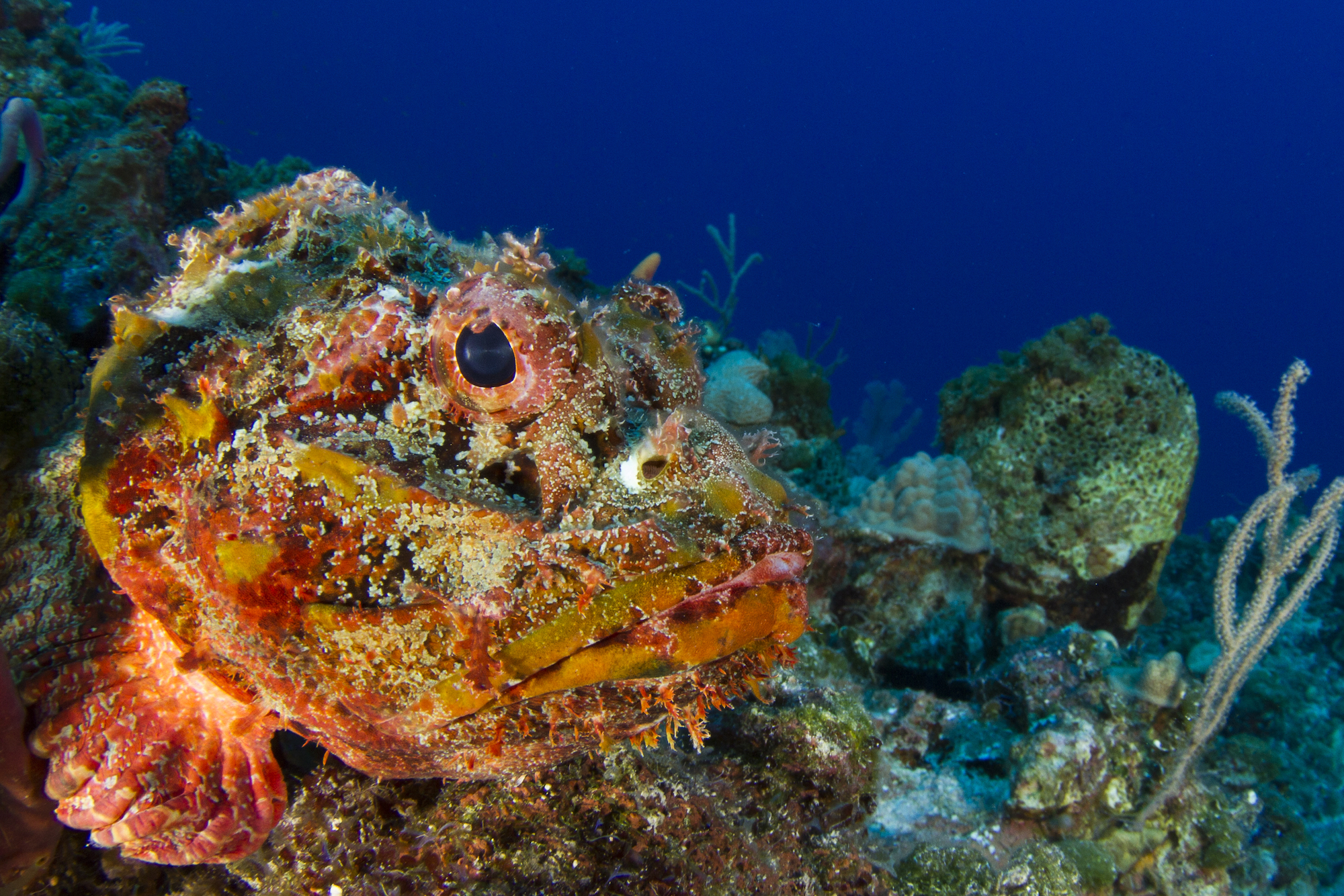
A poisonous Stonefish camouflages itself in a reef. Photograph: Andy Deitsch/Shutterstock
The sting from a stonefish is said to feel like being crucified…mixed with burning from a torch…oh aye and topped off with a periodic whack from a sledgehammer. And that's only if y'all survive – which, let's be honest, y'all might be begging for the "Old Yeller Special" if those descriptions are real. But, sorry to break it to yous, most people survive stonefish stings. So if y'all footstep on one, prepare for a world of pain.
What to do if yous encounter one:You probably won't meet it as stonefish are masters of disguise. But if you step on 1, alarm emergency services, submerge the sting in the hottest water the victim tin handle, begin handling with anti-venom, and ability through the pain.
Where to find 'em: Stonefish are constitute in the coastal regions of the west Pacific and Indian oceans, and parts of northern Commonwealth of australia. Their natural habitat is to blend into their ocean floor surroundings, so coral reefs, rocky areas, and basically anything other than a pure sand bottom.
Blue-Ringed Octopus
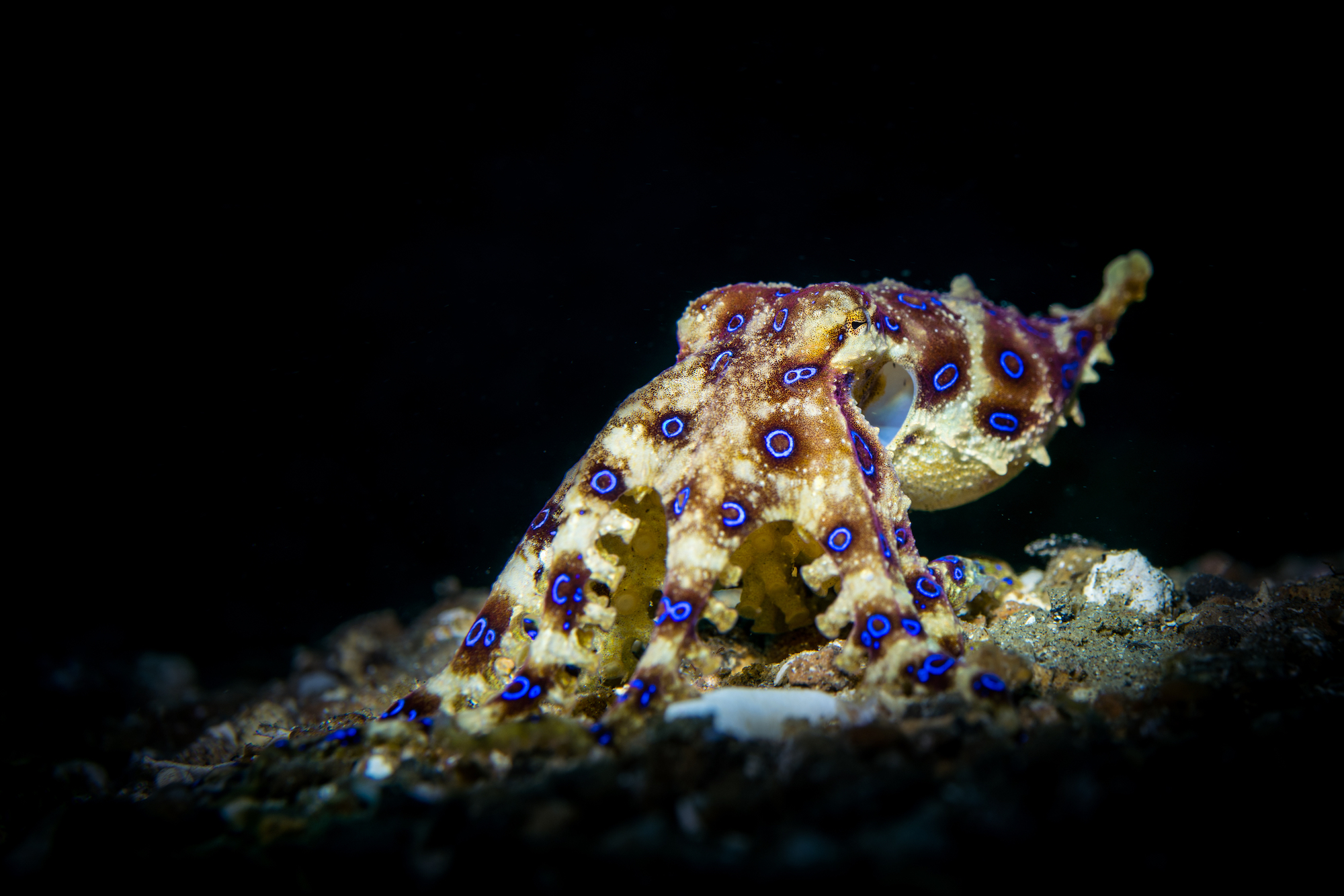
A Blue-Ringed Octopus in Lembeh Strait, Sulawesi, Indonesia. Photo: Sascha Janson/Shutterstock
Did you know that all octopuses (octopi?) are venomous? It's true, but few pack a dial like the tiny blue-ringed octopus. With venom one,000 times more powerful than cyanide, the blue-ringed octopus is considered ane of the deadliest creatures on earth. If bitten by the beak of these guys – which humans won't even feel because it's so small-scale – the octopus tin so release its venom into the bloodstream. If untreated, a seize with teeth can result in decease within 24 hours or as little as 20 minutes.
What to do if you encounter one:They may expect cute and cuddly but do not pick i upward. Repeat: Do Non. Most bites from these guys occur when someone tries to touch one — that's when they become frightened and use defense force tactics. If bitten and it'southward serious, artificial respiration is required equally the venom is designed to paralyze its victim.
Where to detect 'em: The Indo-West Pacific (from the Indian Ocean to the western/cardinal Pacific) is where y'all're about likely to see a blue-ringed octopus – that means northern Australia, Indonesia, and certain island chains in the Pacific.
Stingrays

Stingrays are typically pretty docile creatures; only when they're threatened, they can do some serious damage. Photograph: Shutterstock
RIP Steve Irwin. Man, what a loss. If you lot'll remember, the belatedly-neat Crocodile Hunter died while filming off the coast of Queensland, Australia when he was attacked by a stingray. Within a matter of seconds, the ray stabbed Irwin multiple times with its tail, and i blow struck him in the heart. Typically, surfers and swimmers might step on a stingray, resulting in a venomous sting from the barbs in their tails, which can be extremely painful. But is it deadly? Not commonly.
What to practice if y'all come across one:Most stings from rays occur on the feet or legs, as these guys are bottom-feeders. Soak the stung area in the hottest h2o possible (this reduces the pain). If the barb is withal stuck in the skin, a surgical extraction could be necessary.
Where to find 'em: Since there are so many species of rays, y'all tin can pretty much name an ocean and they'll exist there in some grade or some other. The short-tailed stingray (which killed Irwin) tin can be found off the coasts of Australia and Africa. In California, in that location's the round stingray. Hawaii is home to manta rays, wide stingrays, and eagle rays. And there's scores of others across the globe.
Beaked Bounding main Ophidian
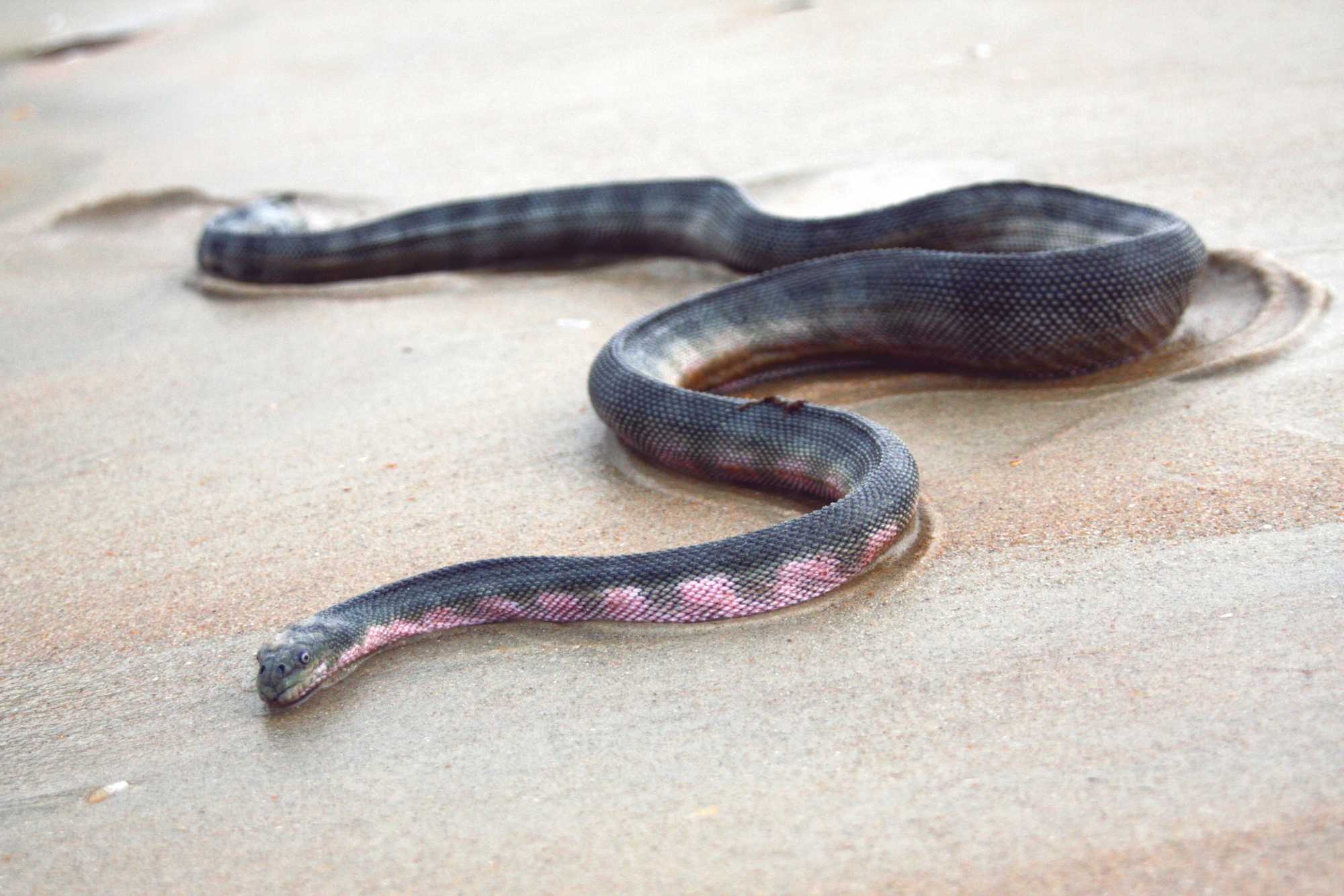
Land, water — the beaked bounding main ophidian can handle both. And how evil does that thing look? No wonder lots of people are afraid of snakes. Photo: Raimonds Romans/Shutterstock
Like octopuses, all bounding main snakes are venomous. Merely they also vary in deadliness and, more than importantly, aggressiveness. For instance, the Dubois' ocean snake is the most venomous snake on the planet; just in the wild, information technology'due south adequately docile. By contrast, the beaked or hook-nosed sea serpent is less venomous, but it'south far more than aggressive (it's responsible for ninety% of all sea snake bites), which makes it more of a threat.
What to practice if you run across one:Don't provoke it. As mentioned above, these guys tin be aggressive when provoked. If bitten, contact emergency services and they'll administer anti-venom.
Where to find 'em: Beaked ocean snakes are primarily found around the coast and littoral islands of India. And in northern Australia, where they're chosen hook-nosed sea snakes, they've likewise been known to hang out.
Crocodiles

Masters of stealth, expert hunters — when a croc enters the lineup, you don't wanna be anywhere almost it. Photograph: Shutterstock
To the armchair zoologist, crocodiles may seem similar an inconsequential threat to bounding main swimmers and surfers. Hence, their proclivity towards rivers, swamps, and lakes. Just in certain places – ahem, Republic of costa rica – crocs have been known to enter the lineup through rivermouths. (The American Crocodile, establish in Costa rica, is i of the just species of crocs comfortable in saltwater). They're aggressive, elusive, and natural-born killers specially adapted over millennia. For some perspective, after a terrible assail on an American surfer in Costa rica, Kelly Slater told Surfline that he'd "admittedly" rather surf with sharks over crocs.
What to do if you come across ane:You probably won't see it as these guys are notorious for their stealth hunting method. But if you do see one, or someone mentions seeing one while in the lineup, exit the water immediately. Also avoid rivermouths and estuaries while in areas where crocs are known to hang out.
Where to detect 'em: Equally mentioned in a higher place, Costa Rica has become notorious for croc attacks on surfers and swimmers. But the American Crocodile tin be constitute throughout Central America, Florida, and the Caribbean. And other species of saltwater crocs are prevalent in the Indian Ocean (there was a fatal attack on a surfer recently in Sri Lanka) and Australia.
Smashing White Shark
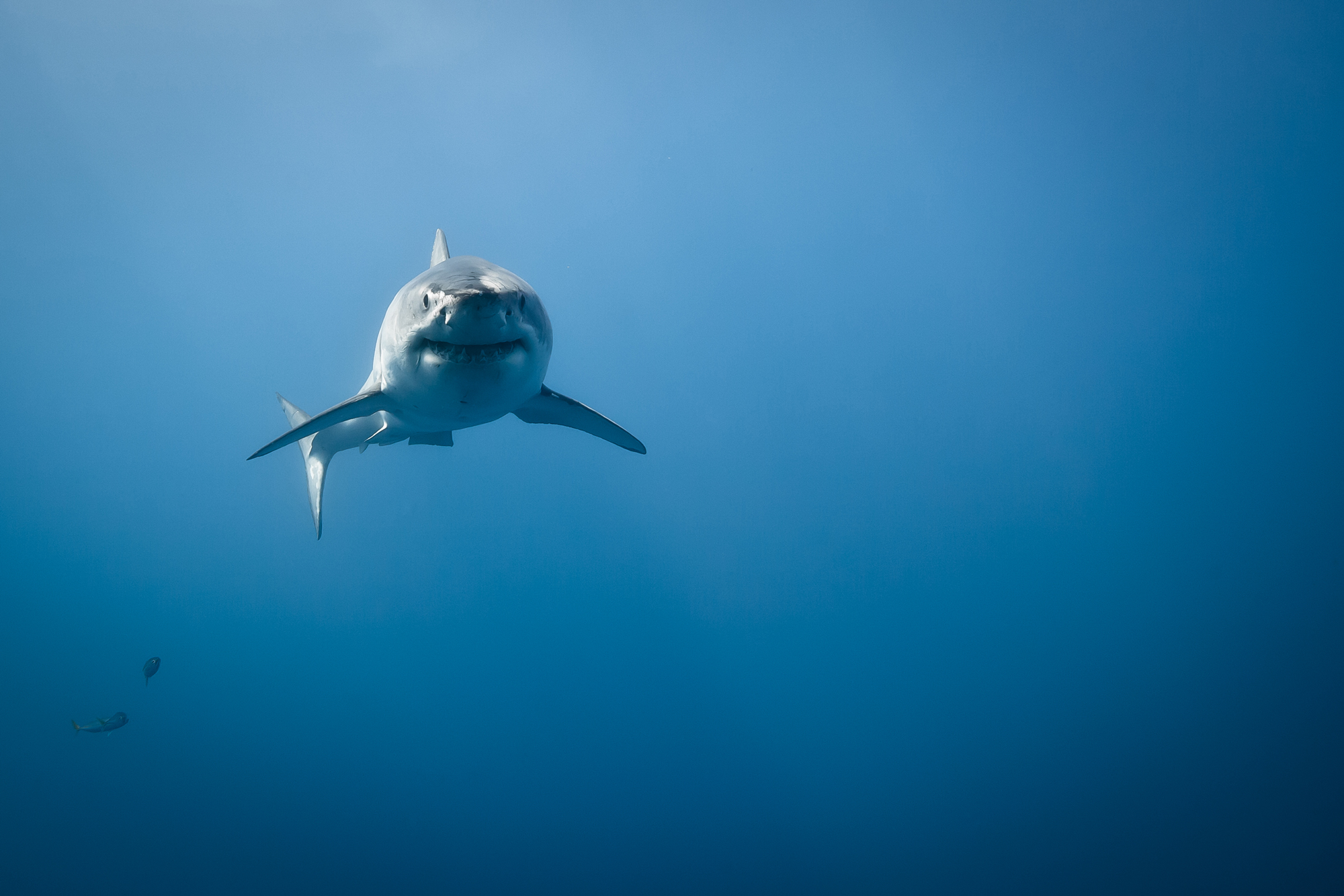
The eternal nightmare of whatsoever surfer, swimmer, or viewer of Jaws: the corking white shark. Photo: Shutterstock
This one'south a given. Sharks are responsible for thousands of unprovoked attacks on humans across the globe since the year 1580, reports the International Shark Attack File. And while certain species are more, let'due south say curious, when information technology comes to humans equally prey – Bull Sharks, Tiger Sharks come up to listen – the Smashing White can do the most damage. They're backside the most attacks on humans, the most fatalities, and – peradventure virtually chilling – they tin be constitute in whatever and every sea beyond the earth.
What to do if you encounter ane:Don't panic, and get out of there as calmly as possible. For more than, read this: How to Avert Getting Attacked by a Shark.
Where to find 'em: Everywhere except your bathtub. Simply they're more prevalent in certain places over others – California, Baja, Hawaii, South Africa, and others.
Humans
Whether information technology's pollution, accidents, or archetype human being ineptitude – humans are by far the well-nigh unsafe animate being in the ocean. And a lot of the times, the destruction is self-inflicted. And then, the next time you're out surfing and yous're worried near what lurks beneath, merely remember: the creature almost probable to hurt you is yourself and/or the surfers (or standup paddleboarders, foilboarders, etc.) around you lot. Nobody is rubber.
What to practise if you come across one:Keep your distance.
Where to find 'em: Expect in a mirror.
Expert forecasts
Surfline's team of meteorologists provide detailed forecasts for thousands of breaks around the earth. Start your gratis trial to Surfline Premium and we'll assistance you know before you go.
Source: https://www.surfline.com/surf-news/dangerous-ocean-creatures/44406
Posted by: thomasexprooking.blogspot.com

0 Response to "What Is The Most Dangerous Ocean Animal"
Post a Comment